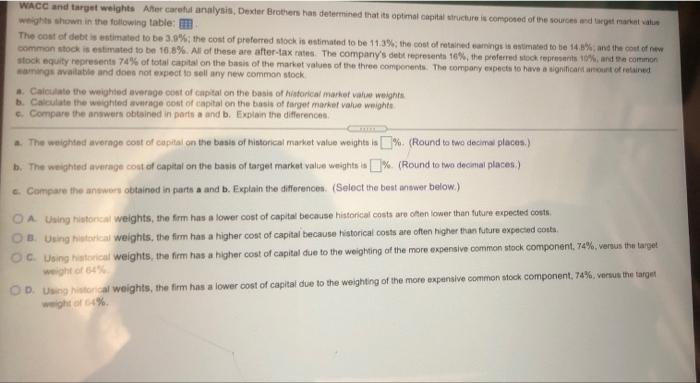WACC and target weights Aer carta analysis, Dexter Brothers han determined that its optimal capital structure is composed of the sources and eget market value weights shown in the following table: mm The cost of debt is estimated to be 3.8%; the cost of preferred stock is estimated to be 11.3%; the cost of retained camnings is estimated to be 14%, and the cost of new common stock is estimated to be 16.8%. All of these are after-tax rates. The company's debt represents 10%, the preferred stock represents 10%, and common stock equity represents 74% of total capital on the basis of the market values of the three components. The company expects to have a significant amount of retained wings available and does not expect to sell any new common stock - Calculate the weighted average cost of capital on the basis of historical market value weights b. Calculate the weighted average cost of capital on the basis of target market value weight c. Compare the answers obtained in partea and b. Explain the differences The weighted average cost of capital on the basis of historical market value weight is % (Round to two decimal places.) b. The weighted average cost of capital on the basis of target market value weight % (Round to two decimal places) 6. Compare the answers obtained in partea and b. Explain the differences. (Select the best answer below) O A Using historical weights, the firm has a lower cost of capital because historical costs are often lower than future expected costs OB. Using historical weights, the firm has a higher cost of capital because historical couts are often higher than future expected costa Oc Using historical weights, the firm has a higher cost of capital due to the weighting of the more expensive common stock component. 74%, versus the target weight of 4 OD. Uw historcal weights, the firm has a lower cost of capital due to the weighting of the more expensive common stock component, 74% versus the target ght % - historical weights, the firm has a lower cost of capital due to the weighting of the more expensive common stock component 74%, versus the target ht of 64%. Data table (Click on the icon here in order to copy the contents of the data table below into a spreadsheet.) Target market Source of capital value weight Long-term debt 21% Preferred stock 15 Common stock equity 64 Total 100% 318 Print Done WACC and target weights Aer carta analysis, Dexter Brothers han determined that its optimal capital structure is composed of the sources and eget market value weights shown in the following table: mm The cost of debt is estimated to be 3.8%; the cost of preferred stock is estimated to be 11.3%; the cost of retained camnings is estimated to be 14%, and the cost of new common stock is estimated to be 16.8%. All of these are after-tax rates. The company's debt represents 10%, the preferred stock represents 10%, and common stock equity represents 74% of total capital on the basis of the market values of the three components. The company expects to have a significant amount of retained wings available and does not expect to sell any new common stock - Calculate the weighted average cost of capital on the basis of historical market value weights b. Calculate the weighted average cost of capital on the basis of target market value weight c. Compare the answers obtained in partea and b. Explain the differences The weighted average cost of capital on the basis of historical market value weight is % (Round to two decimal places.) b. The weighted average cost of capital on the basis of target market value weight % (Round to two decimal places) 6. Compare the answers obtained in partea and b. Explain the differences. (Select the best answer below) O A Using historical weights, the firm has a lower cost of capital because historical costs are often lower than future expected costs OB. Using historical weights, the firm has a higher cost of capital because historical couts are often higher than future expected costa Oc Using historical weights, the firm has a higher cost of capital due to the weighting of the more expensive common stock component. 74%, versus the target weight of 4 OD. Uw historcal weights, the firm has a lower cost of capital due to the weighting of the more expensive common stock component, 74% versus the target ght % - historical weights, the firm has a lower cost of capital due to the weighting of the more expensive common stock component 74%, versus the target ht of 64%. Data table (Click on the icon here in order to copy the contents of the data table below into a spreadsheet.) Target market Source of capital value weight Long-term debt 21% Preferred stock 15 Common stock equity 64 Total 100% 318 Print Done








